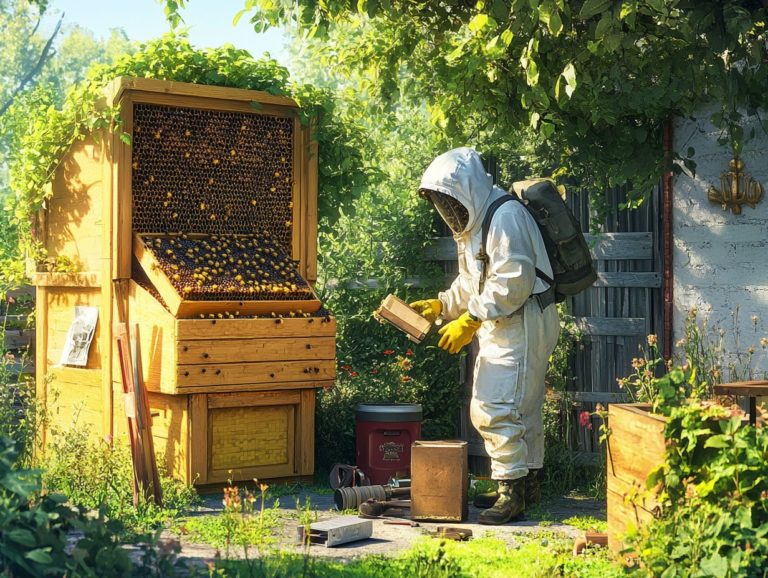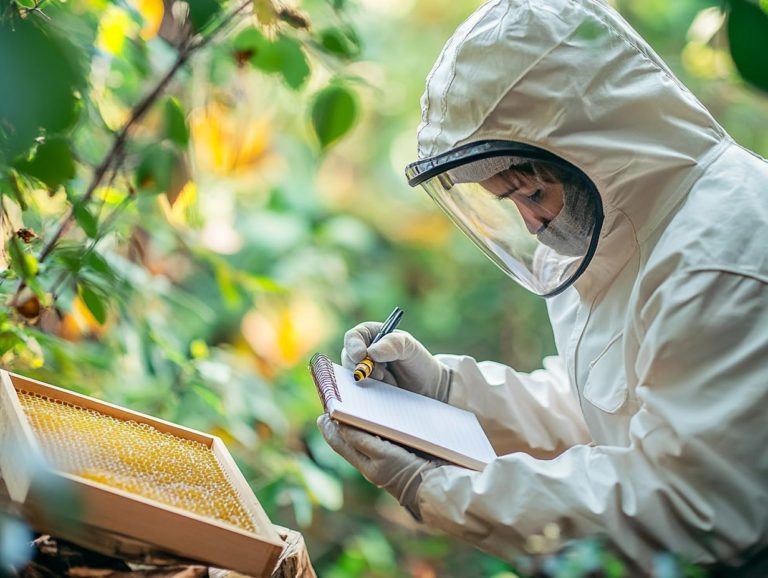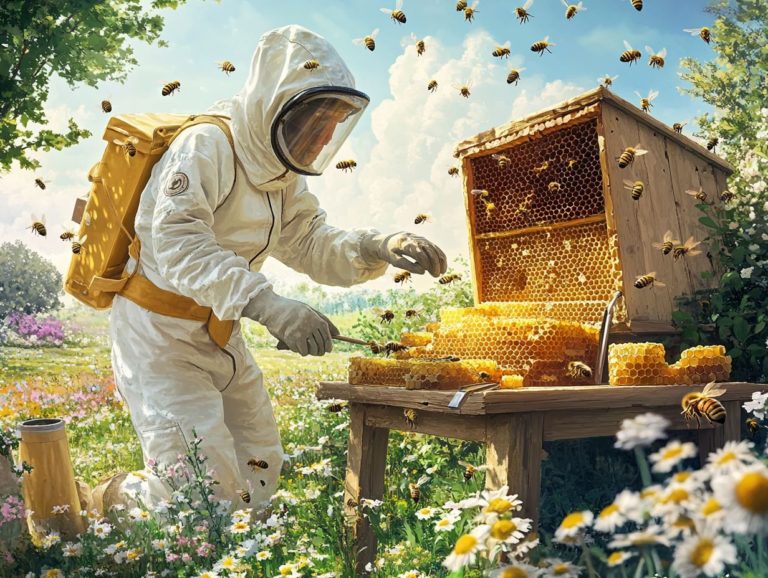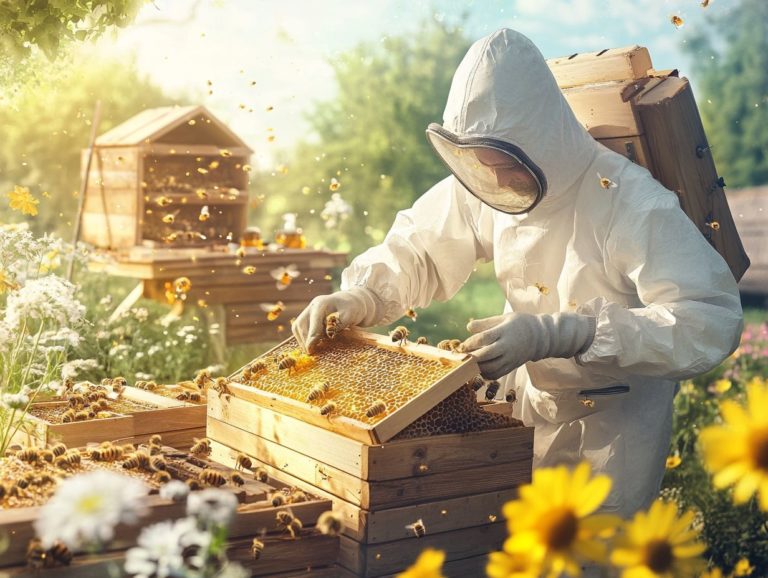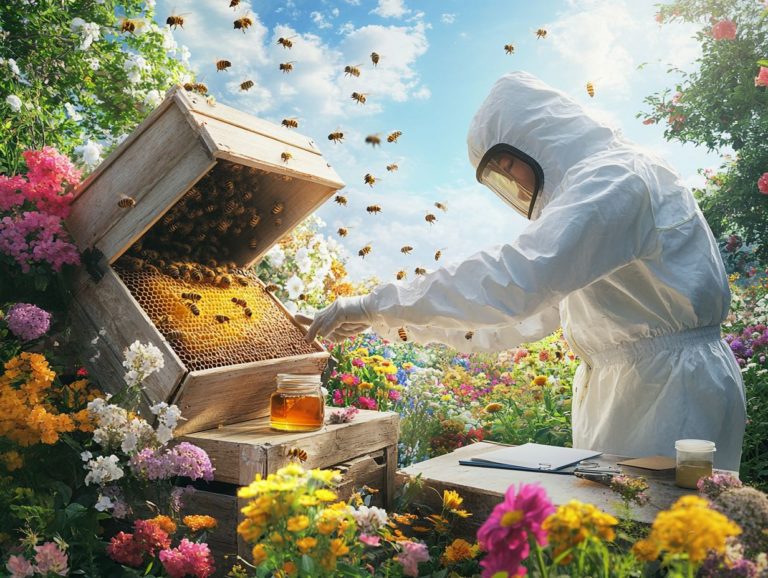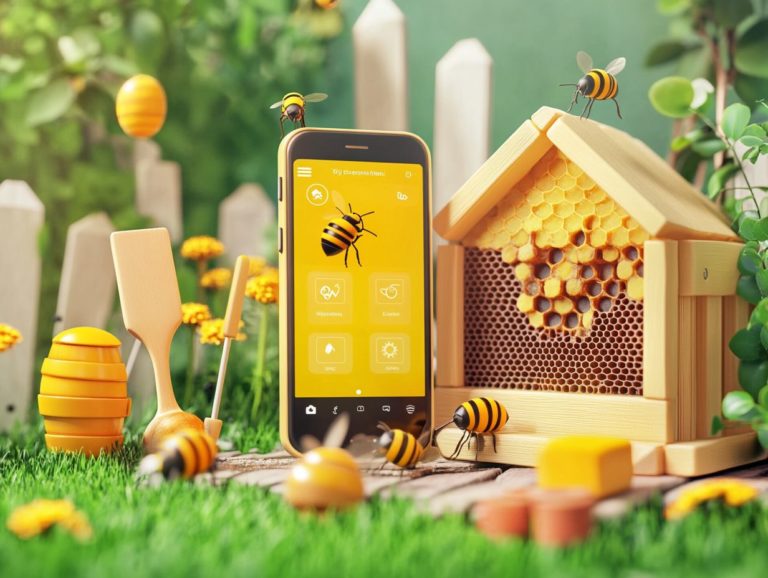Identifying Key Hive Management Indicators
Mastering hive management is the key to thriving bee health and optimizing honey production. Utilizing advanced hive monitoring, data collection, and analytics applications can help you achieve these goals.
By grasping the important signs to monitor in your hive, including hive weight and internal temperature, you can evaluate the health of your hive and identify potential issues before they escalate into serious problems.
This guide will illuminate the crucial signs of both a thriving and declining hive. It will provide insights on how to monitor these signs and explain their significance.
By mastering these techniques, you’ll be empowered to make informed, data-driven decisions that elevate your hive’s vitality and productivity.
Contents
- Key Takeaways:
- The Importance of Hive Management
- What are Important Signs to Monitor in Your Hive?
- How to Monitor Key Hive Management Indicators?
- Why are Key Hive Management Indicators Important for Organizational Success?
- How to Use Key Hive Management Indicators for Data-Driven Decisions?
- Frequently Asked Questions
- What are key hive management indicators?
- Why is it important to identify key hive management indicators for successful beekeeping?
- What are some common key hive management indicators and metrics?
- How can I track key hive management indicators and metrics?
- What are some potential red flags when monitoring key hive management indicators and metrics?
- How often should I assess key hive management indicators and metrics?
Key Takeaways:
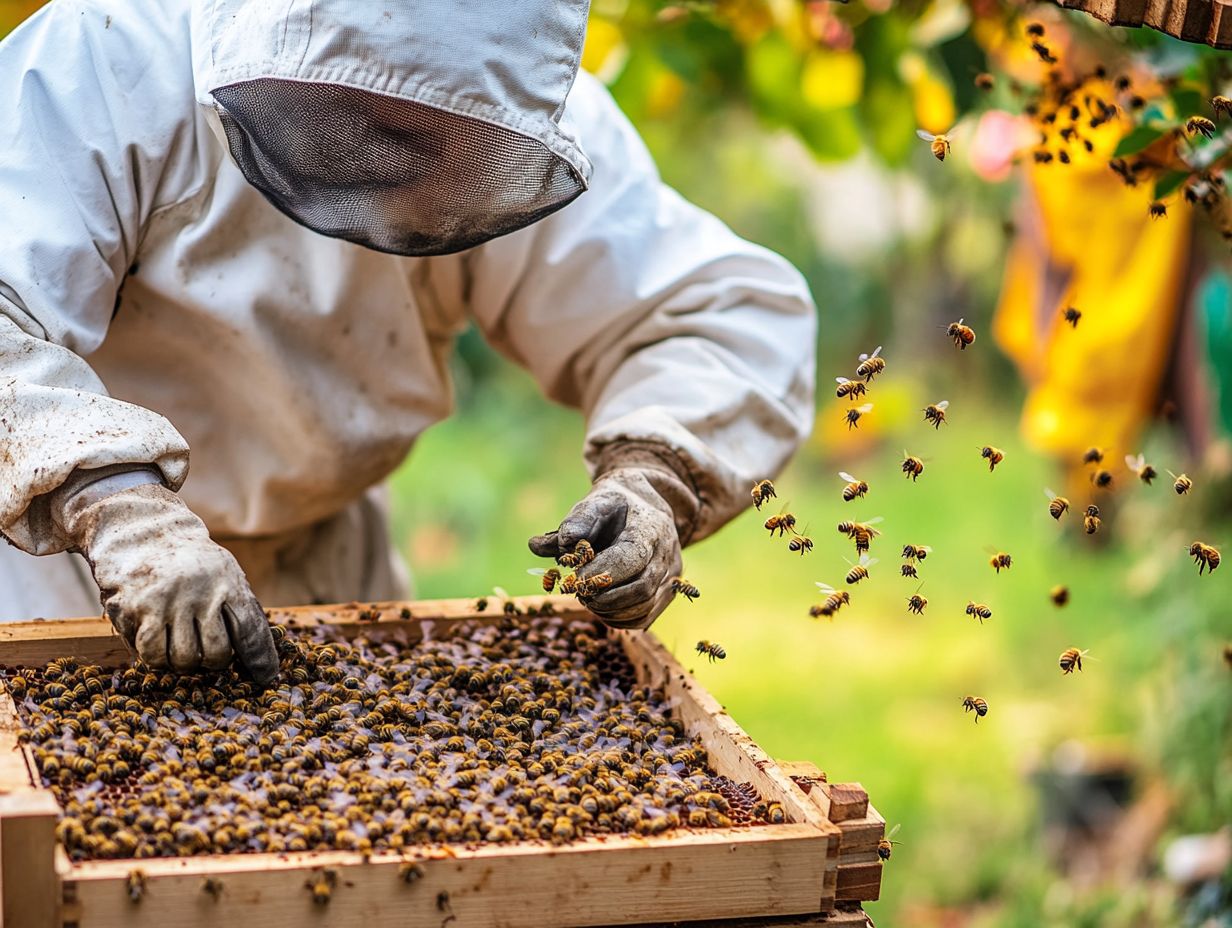
- Regular hive inspections are crucial in monitoring key indicators such as bee population, honey production, hive weight, and brood patterns.
- Early detection of issues can improve hive health and productivity.
- Understanding and tracking key indicators helps beekeepers make informed decisions and implement appropriate management strategies. Monitoring hive weight and temperature inside the hive are also essential practices.
The Importance of Hive Management
Effective hive management is essential for maintaining bee health and promoting successful beekeeping practices. By implementing proper techniques, including pest control measures and varroa management, you can significantly enhance honey production while ensuring the well-being of your honey bee colonies.
This involves strategies like varroa management to combat Varroa mites. Conduct regular hive inspections and use beekeeper resources to collect valuable data on hive conditions through monitoring.
A well-managed hive acts as an early warning system for emerging issues, enabling you to take timely actions to address potential threats and improve overall hive health.
What are Important Signs to Monitor in Your Hive?
Important signs to monitor are crucial metrics to ensure your hive remains healthy and productive. These indicators encompass various parameters, including hive weight, internal temperature, and the overall condition of brood frames. All of these offer valuable insights into the vitality of your honey bee colony. Audio data and temperature inside the hive are also essential metrics.
Additionally, tracking varroa resistance levels and conducting regular inspections will help you spot early signs of distress or decline. By keeping a close eye on these key performance indicators, you can make informed decisions that elevate your hive management strategies and contribute to success in beekeeping.
What are the Signs of a Healthy Hive?
A healthy hive showcases several signs that reflect the well-being of its honey bee population, which is essential for successful beekeeping. As you observe robust bee flight activity, take note this is a primary indicator. You should see bees foraging actively on warm days, returning laden with pollen and nectar.
A consistent presence of brood frames filled with healthy larvae and capped honey cells signals a productive queen and a thriving colony.
Pest identification is equally critical. The absence of Varroa mites and other exotic pests, as identified through tools like the Exotic Plant Pest Hotline, is vital for maintaining optimal bee health. This ensures a hive that can efficiently produce honey. The overall temperament of the bees is another key factor; generally, calm bees suggest stability, while aggressive behavior may signal stress or an impending issue within the colony.
Regular inspections will reveal whether there are sufficient food stores, which are essential for survival, especially during colder months when foraging isn t an option. Monitoring the presence of strong worker bees those capable of performing various tasks further indicates a well-functioning hive.
All these signs, when considered together, provide you with valuable insights into your hive’s productivity and longevity, enabling you to manage proactively and intervene when necessary.
What are the Signs of a Declining Hive?
Recognizing the signs of a declining hive is crucial for you as a beekeeper. This allows you to take timely action and prevent potential collapse.
Common indicators of trouble include diminished bee activity and an unusual number of dead bees at the entrance. You should also watch for unmistakable signs of disease like American foulbrood or European foulbrood. If left unchecked, these can swiftly decimate your colony.
Ineffective varroa management can worsen the situation by increasing mite populations and stressing the colony. By promptly identifying these warning signs, you can implement effective pest control measures and restore hive health before it spirals out of control.
A sudden drop in honey production may also hint at underlying issues within your hive. Pay attention to any uncharacteristic behavior in the worker bees, such as erratic foraging patterns or reduced brood rearing; these can provide essential clues. Using simple data tools like Power BI can assist in understanding these patterns better.
Regular hive inspections are critical! They help you catch problems early and keep your bees healthy. It’s vital to keep meticulous records, enabling you to analyze trends over time. Early intervention is key; it not only aids in diagnosing the problem but also enhances the overall resilience of your hive.
Act quickly to tackle pest infestations and disease. This is crucial for keeping your bee population healthy and thriving!
How to Monitor Key Hive Management Indicators?
Monitoring key hive management indicators is essential for you as a beekeeper to ensure the longevity and productivity of your honey bee colonies. Regular hive inspections are your primary tool for assessing the status of your hives; they allow you to observe bee behavior and brood patterns.
Using modern equipment, like electronic beehives and cloud-based dashboards, can significantly enhance your experience by facilitating data visualization and enabling real-time tracking of critical metrics, such as hive weight and bee flight activity.
By utilizing analytics applications, you empower yourself to make informed, data-driven decisions that elevate your hive management strategies to new heights.
1. Regular Hive Inspections
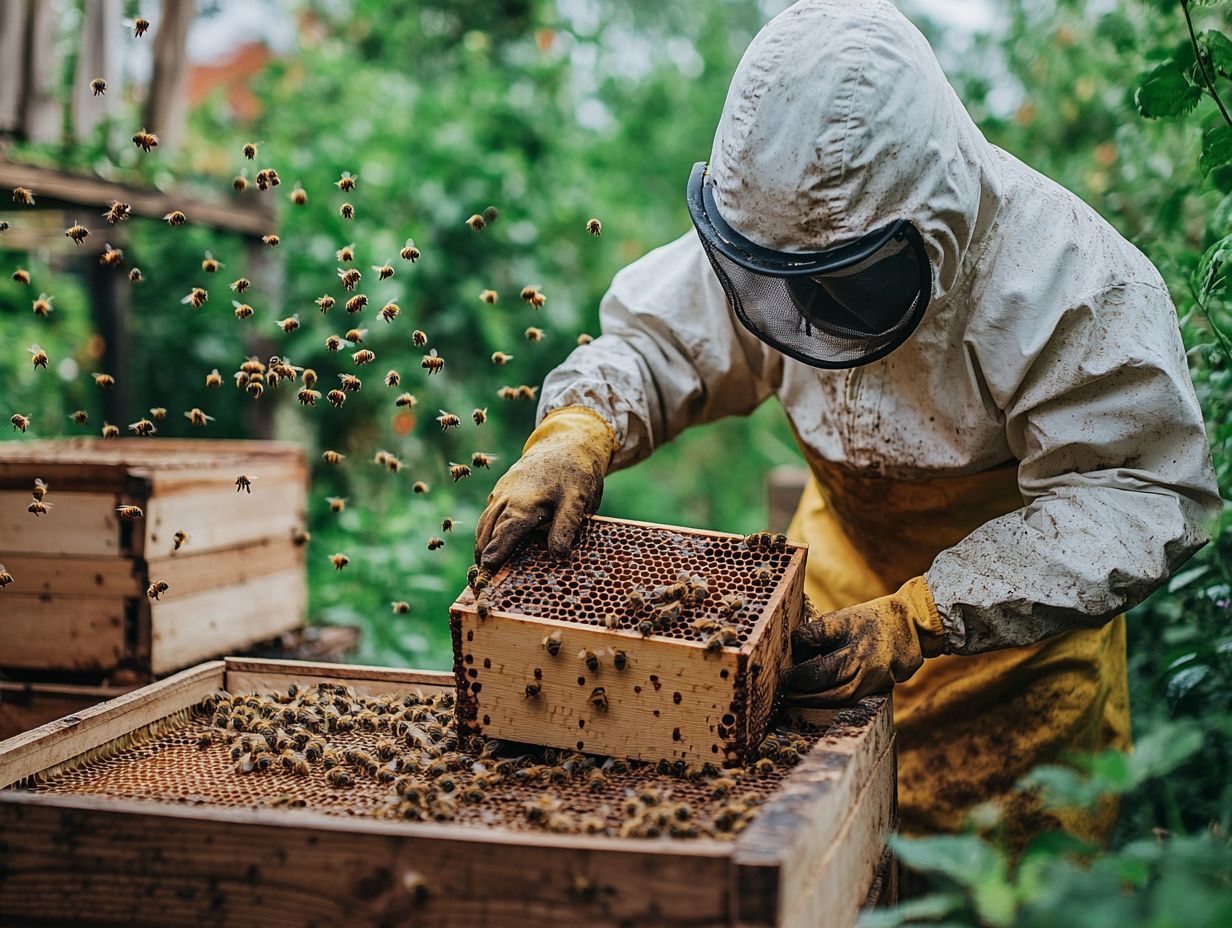
Conducting regular hive inspections is essential for maintaining bee health and ensuring effective hive management. You should utilize proper hive tools to examine each brood frame for signs of healthy larvae, adequate honey stores, and the overall activity within the colony.
These inspections enable you to identify potential issues early, such as the presence of pests or diseases, and monitor the general condition of your hive. Consistent inspections help you create an optimal environment for the bees, ultimately promoting a robust and productive colony. Tracking KPIs such as larval health and honey production during these inspections is also recommended.
To keep your hive vibrant, aim for inspections every 7 to 14 days during the busy spring and summer months. When you conduct these checks, pay careful attention not only to the brood pattern but also to the overall behavior of the worker bees, as this can offer valuable insights into the colony s health.
Using essential hive tools, such as a smoker and hive tool, to pry open frames minimizes stress on the bees and keeps you protected.
Monitoring for signs of queen performance, including egg-laying patterns and the presence of queen cells, is crucial. By being attentive to these details, you can ensure your bees are thriving and effectively manage any challenges that arise.
2. Monitoring Honey Production
Monitoring honey production is essential for you as a beekeeper to gauge the success and productivity of your hives. This process involves regularly checking the hive weight to determine honey stores and observing bee flight activity to assess foraging efficiency. A steady increase in hive weight generally indicates that your colony is healthy and thriving, fully capable of producing honey.
By paying close attention to these aspects, you can make informed decisions about honey harvesting and evaluate the overall effectiveness of your beekeeping strategies.
Understanding the dynamics of hive weight changes is crucial for your success in honey production. Regular weight checks not only reveal how much honey has been stored but can also signal potential issues, such as the presence of pests or diseases that could disrupt production.
Tracking the number of bees returning with pollen can provide valuable insights into their foraging success and the availability of local floral resources. Together, these monitoring methods equip you with the necessary information to optimize your hive management practices, ensuring your colonies maintain robust health and ultimately contribute to a bountiful honey yield.
3. Tracking Bee Population
Tracking bee population is vital for monitoring hive health and ensuring your beekeeping practices are on point. By routinely checking brood frames and estimating the number of bees in your hives, you can assess population trends and quickly identify any sudden declines that might signal underlying issues. These could range from pest infestations to diseases that threaten the survival of your colony. Employing electronic beehive technology and audio data can further aid in precise population tracking.
Keeping an accurate count of the bee population enables you to implement timely pest control measures and make informed decisions about hive management.
Employing tools like bee counters alongside observational techniques can significantly enhance the accuracy of your population assessments. By observing the behavior and condition of your brood frames, you gain invaluable insights into the developmental stages of your colony, which is essential for understanding its overall health. A robust population usually indicates a thriving hive, while a drop in numbers might point to stressors that require your attention. Incorporating varroa management practices can also help mitigate these stressors.
By closely monitoring these critical indicators, you can fine-tune your management strategies, ensuring the resilience and productivity of your hives through informed interventions and attentive care. Utilizing beekeepers resources, such as the Honey Bee Health Coalition, can provide additional support and guidance.
4. Observing Brood Patterns
Observing brood patterns is essential for assessing the health of your hive, as these patterns reveal crucial insights about the colony’s reproductive success and overall vitality. When you notice healthy brood patterns characterized by evenly spaced and properly capped cells it s a clear sign of a productive queen and thriving larval health. This practice also aids in early pest identification, allowing you to take swift action against potential threats like the European foulbrood.
An abundance of healthy brood indicates that your hive is flourishing and well-equipped to support future generations of bees. On the flip side, if you spot irregularities in brood patterns, like sporadic patches or a noticeable decline in open cells, it can signal potential problems, such as queen failure, pest infestations, or issues related to hive health practices.
Taking swift action whether that means requeening, adjusting hive conditions, or treating for diseases can significantly bolster your colony’s resilience and productivity. Thus, integrating brood pattern observations into your regular hive inspections equips you with vital insights that ensure your colonies not only survive but truly thrive.
5. Checking for Pests and Diseases
Regularly inspecting for pests and diseases is crucial for maintaining the health of your bee colony and ensuring that your beekeeping practices thrive. Employing tools like hive tools and techniques such as pest control can significantly aid in this process.
This proactive approach is essential because various pests and pathogens present significant risks to your bees’ well-being. They also affect agricultural productivity on a larger scale. Take the Varroa destructor mite, for instance; this tiny parasite weakens individual bees and spreads harmful viruses that can wipe out an entire hive if you let it go unchecked. Then there are bacterial infections like American foulbrood and European foulbrood, which can be particularly insidious and lead to colony collapse.
To combat these threats effectively, you should adopt overall pest management strategies think along the lines of using screened bottom boards, sugar dusting, or applying approved chemical treatments regularly. Frequent hive inspections are vital for early detection and intervention, allowing you to address potential issues promptly. This will ultimately result in healthier colonies and increased honey yields. Consider exotic pests like the Tropilaelaps mite to enhance your understanding of hive health and leveraging resources like the Exotic Plant Pest Hotline can be beneficial.
Why are Key Hive Management Indicators Important for Organizational Success?
Key hive management indicators play a crucial role for you as a beekeeper, offering invaluable insights into the health and productivity of your honey bee colonies. These indicators enable you to detect potential issues early on, allowing you to take corrective actions before minor problems escalate into significant threats. Monitoring your time to acknowledge issues can also help streamline your response strategies.
By adopting effective hive health practices and employing data collection methods, you can meticulously track KPIs that reflect the status of your hives. Furthermore, consistently monitoring these indicators helps you identify pests, ensuring that your management strategies remain effectively aligned with the evolving needs of your colony. Collaborative efforts like those from the Honey Bee Health Coalition can offer additional insights and resources.
1. Early Detection of Issues and Time to Detect
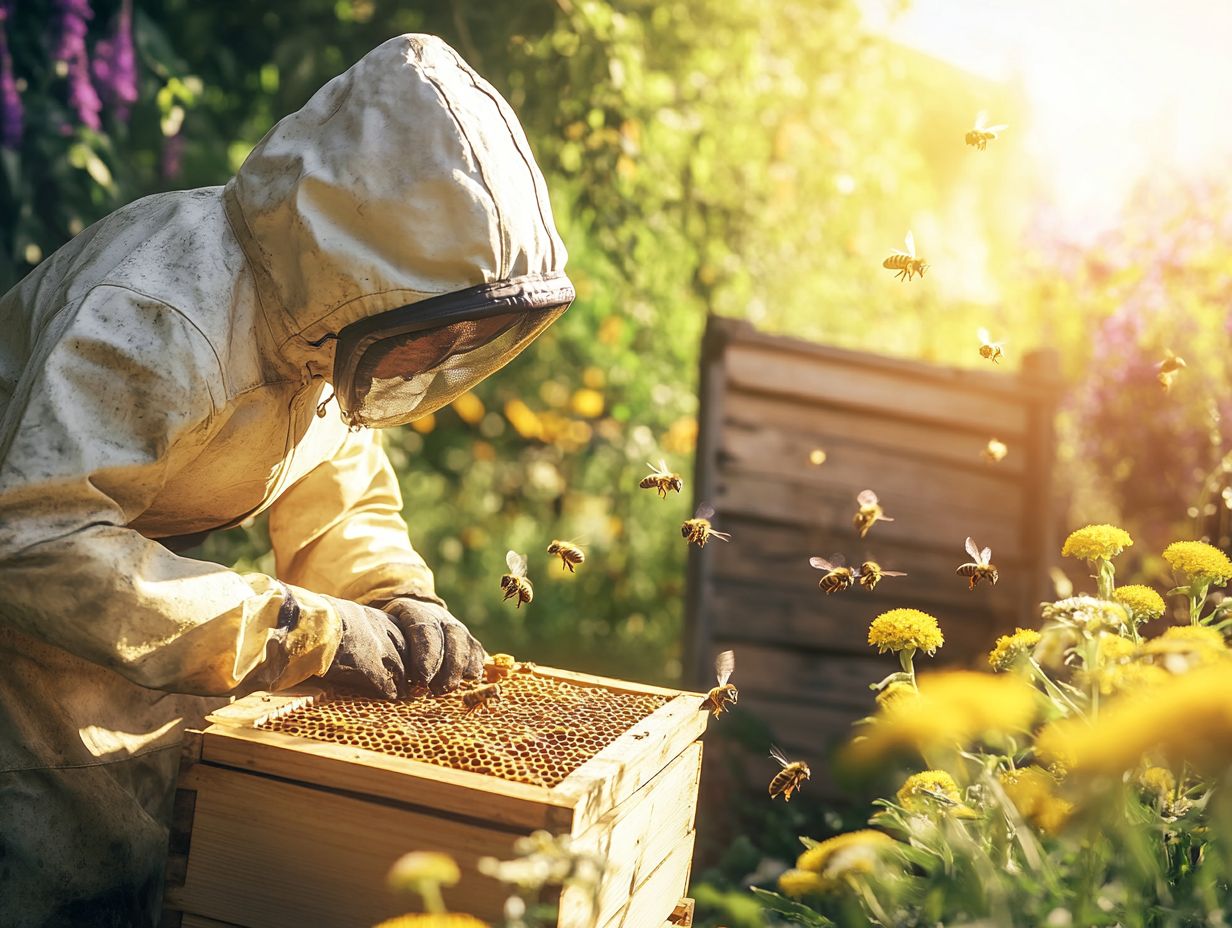
Detecting issues early is crucial for maintaining the health of your honey bee colonies and ensuring successful beekeeping. By employing effective monitoring strategies and utilizing data collection techniques, you can identify potential problems before they escalate. This proactive approach empowers you to take swift action, whether it’s addressing signs of disease or tackling pest infestations, ensuring that your colonies remain robust and productive.
Early detection is vital to safeguard your hive s health and ensure your bees thrive. Monitoring the time to detect and the time to triage these issues can provide better insights into your hive management efficiency.
Embracing technology, such as hive sensors, allows you to monitor temperature, humidity, and even the sounds of your bees signals that could indicate distress. Regular inspections, paired with thorough data analysis, provide you with a comprehensive understanding of hive dynamics, fostering an environment where your bees can truly thrive.
Incorporating practices like routine varroa mite checks, varroa resistance breeding programs, and maintaining cleanliness within your hives can significantly reduce threats. When these techniques work in harmony, they not only bolster the stability of your bee populations but also pave the way for greater honey yields and sustainability in your apiculture endeavors.
2. Improving Hive Health, Productivity, and Tracking KPIs
Improving hive health and productivity stands as a primary goal for you as a beekeeper. This goal directly influences your success in beekeeping practices and honey production.
By concentrating on measurable factors related to hive conditions, you can implement targeted strategies that enhance the overall vitality of your colonies. Tracking KPI metrics provides detailed insights into hive health and productivity.
Several effective methods are at your disposal to boost hive health. Regular monitoring for pests and diseases, employing methods to control pests, and selecting bee species that are resilient to local environmental conditions can significantly improve your hives’ well-being.
Using hive monitoring tools and electronic beehive systems can provide real-time data for more precise interventions. Adhering to best practices during hive inspections is also crucial, as it allows you to identify and address issues before they escalate into more significant problems.
Tracking KPIs such as brood development, honey stores, and queen productivity offers valuable insights into your colony’s performance. Utilizing hive weight and temperature inside the hive as additional KPIs can further enhance your understanding of hive health.
By cultivating a more comprehensive understanding of these factors, you can tailor your efforts to meet the specific needs of your colonies. This approach ultimately leads to a thriving apiary that not only yields more honey but also promotes biodiversity and sustainability within the ecosystem.
3. Making Informed Management Decisions: Data-Driven Decisions and Project Management
Making informed management decisions is essential for you as a beekeeper aiming for optimal hive health and honey production. By effectively tracking KPIs and utilizing analytics applications, you can leverage data-driven decisions that enhance your hive management strategies.
Tools like Tableau, Power BI, Klipfolio, and Domo can be particularly effective in visualizing and analyzing hive data. Incorporating temperature and humidity sensors, along with monitoring bee activity levels, allows you to gain real-time insights into the hive environment.
This enables you to identify trends over time, including seasonal variations that may influence honey yield and bee behavior. Additionally, tracking audio data and bee flight activity can provide deeper insights into colony health and behavior.
Understanding how factors like forage availability impact colony strength enables you to plan your interventions strategically. By adopting a methodical approach that blends traditional knowledge with modern technology, you can maximize your efficiency, leading to healthier colonies, increased honey production, and ultimately, a more sustainable beekeeping practice.
How to Use Key Hive Management Indicators for Data-Driven Decisions?
Utilizing key hive management indicators for your decision-making is essential if you re looking to elevate your beekeeping operations and outcomes. By implementing data visualization techniques and leveraging cloud-based dashboards from platforms like GatherIQ or SAS, you can effectively monitor KPIs that reflect the health and productivity of your hives.
These tools allow you to analyze trends and patterns, informing your decisions about hive management practices. Employing analytics applications enables you to extract actionable insights from your data, ultimately leading to more effective and efficient management strategies.
1. Understanding the Data
Understanding the data gathered from hive management indicators is essential for you as a beekeeper to make informed decisions that enhance both colony health and productivity. By effectively analyzing the data related to monitoring hive conditions, you can identify trends and anomalies that may signal emerging issues. Engaging with skilled data artists, such as Jessica Peter, can help you visualize and interpret complex data sets more effectively.
It is crucial for you to understand key indicators of hive health that reflect the hive’s status, which helps you recognize patterns related to bee health and productivity. This knowledge enables you to take proactive measures rather than merely reacting to problems, fostering a healthier environment for your honey bee colonies.
A comprehensive grasp of this data allows you to pinpoint specific areas that require attention, such as nutrient deficits or pest invasions, thereby refining your management strategies. By utilizing tools like hive scales, temperature sensors, and disease monitoring technologies, you can gather objective measurements that directly inform your practices. Monitoring metrics such as hive weight and temperature inside the hive can unveil deeper insights into colony health.
The ability to correlate these indicators with seasonal changes and environmental conditions significantly contributes to optimizing your hive’s performance.
As a result, you can not only safeguard your bees against potential threats but also enhance honey production, leading to more sustainable apiculture and increased profitability.
2. Identifying Patterns and Trends for Beekeepers
Identifying patterns and trends within the data gathered from key hive management indicators is essential for making informed decisions in your beekeeping endeavors. By utilizing analytics applications and data visualization tools like Tableau, Power BI, and Klipfolio, you can visualize the data, making it much easier to spot correlations between hive health, various environmental factors, management practices, and indicators in case of emergencies.
Recognizing these patterns deepens your understanding of bee population dynamics and highlights potential areas for improvement. As you analyze trends over time, including honey production levels and varroa management, you can adjust your management strategies to optimize the performance and productivity of your hives.
Employing methods such as statistical analysis and computer programs that learn from data allows you to uncover valuable insights that can inform practices like feeding strategies, pest control, and breeding selections. The integration of sensor technology and electronic beehive systems enhances this data landscape by providing real-time monitoring of hive conditions, including temperature inside and bee flight activity.
With such comprehensive insights at your disposal, you are better equipped to make informed choices that not only bolster the sustainability of your operations but also contribute to the overall health of bee populations. Actively using tools from the Honey Bee Health Coalition can save your hives from varroa and other threats. Ultimately, the effective application of these techniques enables you to cultivate resilience against environmental changes, ensuring the longevity and productivity of your hives.
3. Using the Right Management Strategies for Successful Beekeeping
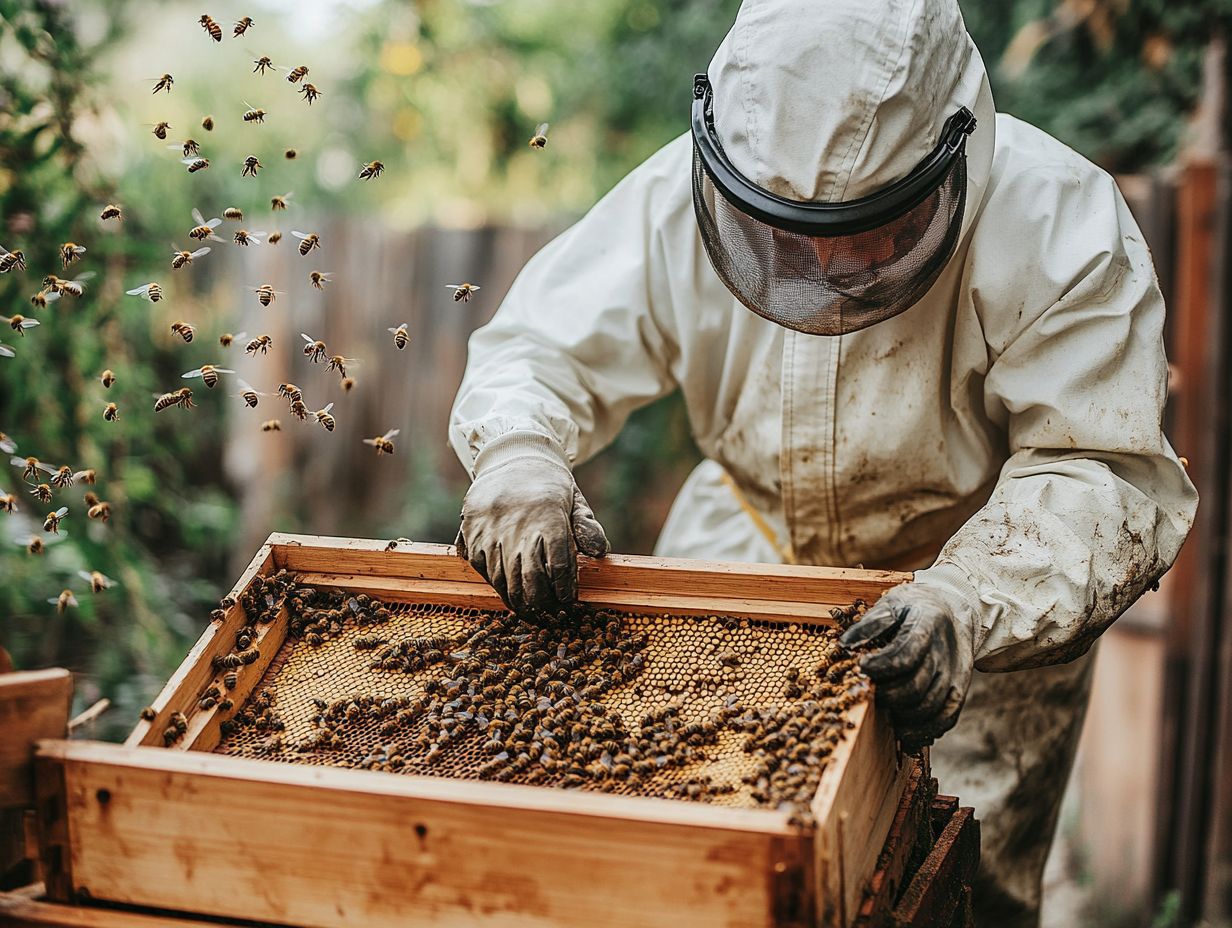
Using effective management strategies can transform your beekeeping experience. By leveraging data-driven decisions and utilizing resources from the Honey Bee Health Coalition, you can tailor your hive management practices to tackle specific challenges such as pest control and disease prevention.
Tracking Key Performance Indicators (KPIs), which are measures that help you assess your hive’s health, enables you to evaluate the effectiveness of your strategies and make necessary adjustments to enhance bee health and productivity. Ultimately, adopting a proactive approach grounded in solid data significantly contributes to the overall success of your beekeeping operations and your organization’s success.
This involves continuously monitoring various indicators, including hive weight, brood patterns, honey production levels, and time to detect issues. By analyzing trends within this data, you can anticipate potential problems such as American foulbrood or European foulbrood and align your interventions with best practices that prioritize the wellbeing of your colonies.
Utilizing technology, such as hive monitoring systems and cloud-based dashboards, enhances your ability to gather and interpret this information accurately. Integrating these management strategies not only strengthens your colony’s resilience but also promotes sustainable practices, ensuring that your beekeeping remains viable and beneficial for both the bees and the environment.
Embracing a data-centric approach enables you to make informed decisions that boost your overall productivity and improve the health of your hives.
Frequently Asked Questions
What are key hive management indicators?
Key hive management indicators are specific measures used to assess the health and productivity of a beehive. These metrics can include factors such as honey production, bee population, and disease prevalence.
Why is it important to identify key hive management indicators for successful beekeeping?
Identifying key hive management indicators allows beekeepers to monitor the overall health and well-being of their hives. This helps them make informed decisions about hive management and take necessary steps for early detection and triage to maintain a thriving bee colony.
What are some common key hive management indicators and metrics?
Common key hive management indicators include honey yield, brood pattern, bee population, mite infestations, larval health, and overall hive weight. These metrics provide valuable insights into the overall health and productivity of a beehive.
How can I track key hive management indicators and metrics?
There are various methods for tracking key hive management indicators, including regular hive inspections, record keeping, and using specialized tools such as hive scales, mite counting devices, and data collection systems. Choose the method that works best for your beekeeping practices.
What are some potential red flags when monitoring key hive management indicators and metrics?
If you notice a significant decrease in honey production, a sudden drop in bee population, or signs of disease or pest infestations, these could be red flags indicating potential issues with your hive. Unusual audio data or changes in bee flight activity can also indicate problems. Act quickly to resolve these issues for the health of your bees!
How often should I assess key hive management indicators and metrics?
It’s recommended to assess key hive management indicators at least once a month, but it may be necessary to do so more frequently during certain times of the year, such as during honey flow season or when treating for pests or diseases like Varroa mites. Regular monitoring, including using tools like the Exotic Plant Pest Hotline for pest identification, can help catch any issues early on and prevent them from worsening.

